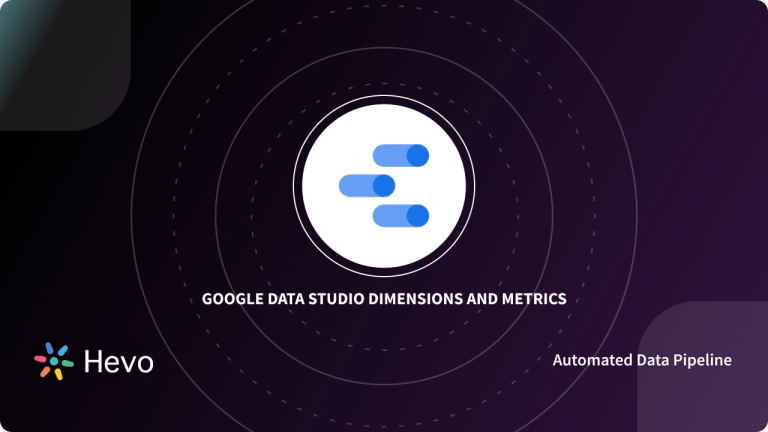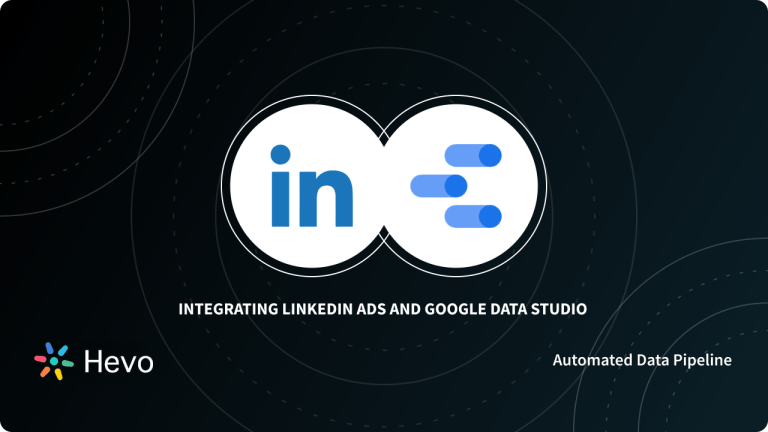Today, SEO (Search Engine Optimization) requires a lot from marketers, and successful SEO strategies rely on third-party tools and the data that they provide.
You can be overwhelmed by the information provided by these tools since it’s not easy to extract actionable insights from the data. That’s why you need Looker Studio. This article will create an SEO Dashboard Google Data Studio.
Table of Contents
Prerequisites
- A Google Data Studio Account.
What is an SEO Dashboard?
- Marketing teams use SEO metrics and KPIs (Key Performance Indicators) to determine the performance of their websites for organic search results. This makes SEO a core function for all marketing teams.
- SEO metrics can help marketing teams know the top converting keywords, top-performing web pages, and website parts that should be optimized for search.
Why Google Data Studio or Looker Studio?
- Data Studio/Looker Studio is a tool developed by Google for data visualization. When data is visualized, one can extract meaningful insights from it for data-driven decision-making.
- With Google Data Studio, you can create a dashboard that tells you everything that you need to know about your SEO.
- You can know the keywords that attract the most clicks, keywords with high impressions but low clicks, posts/pages with the most links, etc. The good thing with Data Studio is that you can pull in your data from different data sources and use it to make an SEO dashboard. And it’s easy to do that!
- When creating SEO reports, you should present key metrics to clients in a simple way so that they can be understood by those not familiar with the data. With Data Studio, you can present complex themes and metrics.
Hevo helps you migrate your data from multiple sources to a single destination, creating a single source of truth. Easily make your data analysis ready for your data visualization.
- Seamless Integration: Consolidate data from multiple sources into one destination.
- Single Source of Truth: Ensure accurate and consistent data for your analysis.
- Analysis-Ready Data: Transform and prepare your data for immediate use.
Experience hassle-free data migration with Hevo. Explore Hevo’s capabilities with a free personalized demo and see how you can benefit.
Get Started with Hevo for FreeDetermine your KPIs (Key Performance Indicators)
- Before diving right into Looker Studio, you must know how you will be measuring the impact of SEO on your business.
- This is not about rankings and traffic only, but it has to do with metrics that will show you the amount of money that SEO is bringing into your business.
- Examples of SEO-related KPIs that you can consider include sales from SEO (E-commerce), new visitors, email list opt-ins, newsletter signups, and contact forms submitted.
- After choosing the KPIs that make sense for your business and setting them up, you will be ready to create your dashboard.
Part 1: Connect to your Data Sources
Follow the steps given below:
- Step 1: Log in to your Looker Studio account using your Google account.
- Step 2: Click the “+ CREATE” button located on the top left corner of the screen.
- Step 3: On the new window that pops up, click “Data source”.
- Step 4: Select the Google Analytics connector.
- Step 5: Select the Account, Property, and the View that you need to connect to. Click the “CONNECT” button located on the top right corner of the screen.
Part 2: Add the Second Data Source
The steps for adding the second data source will differ slightly.
- The reason is that you will be looking at it from the main screen.
- Click the “Resource” menu then choose the “Manage added data sources” option.
- That is where you will be managing all the data sources that you have added.
- If you click the “ADD A DATA SOURCE” button, it will take you to the list of data connectors.
- Just click the connector that you want to use and follow the same steps as we did previously.
- If you need to add data from Bing Ads or Facebook Ads, scroll downwards to the “Partner Connectors” section and choose the applicable source.
- You should now add KPIs to your dashboard.
Part 3: Add a Line Chart
You can use a line chart to track the following KPIs for your website:
- Total unique visitors over time.
- Newsletter opt-ins over time.
- Organic traffic over time.
- Other goals that are directly tied to SEO.
To add a line chart, follow the steps given below:
Step 1: Click the “Add a chart” button from the toolbar. You will be presented with a list of charts that you can add to your dashboard. Select the “Line chart” option from the “Line” section.
Step 2: Drag and drop the chart into the dashboard area.
Step 3: Choose the metric that you need to display from the toolbar provided on the right.
Step 4: Scroll downwards to the “Default date range” section and add the previous period date comparison.
Part 4: Add a Scorecard
You can use a scorecard to track the following KPIs for your website:
- Bounce rate
- Avg pages per session
- Avg time on page
- Organic visitors
- Unique visitors
To make a scorecard, follow the steps given below:
Step 1: Click the “Insert” option from the toolbar. Choose “Scorecard”.
Step 2: Drag and insert it in the dashboard.
Step 3: Select the metric that you need to display from the right pane.
Step 4: Scroll downwards on the pane and select the date range.
Part 5: Adding a Table
You can use a table to track the following KPIs for your website:
- Top Landing Pages with bounce rate, sessions, and avg. time on page.
- Top search queries with impressions, clicks, and click through rate.
To make a table, follow the steps given below:
Step 1: Click the “insert” option from the toolbar then choose “Table”.
Step 2: Drag and drop the table on the dashboard.
Step 3: Select the dimension, which is the main column of the table. Add the metric.
Step 4: Choose the previous date range comparison.
Part 6: Add a Date Slicer
With a date slicer, you can change the periods of the data.
To add a date slicer to your dashboard, follow the steps given below:
Step 1: Click the “Date range” icon from the toolbar.
Step 2: Drag and drop it on the dashboard.
Step 3: Select the default date range.
Your SEO Dashboard Google Data Studio is now up and running.
Part 7: Share your Dashboard
Now that your SEO Dashboard Google Data Studio is ready, it’s time to share it.
Click the “Share” button located on the top right corner of the screen.
Enter the email addresses of the people you need to send the report to, choose whether they can view or edit, then click the “Send” button.
Limitations of SEO Dashboard in Looker Studio
Although Data Studio is a great tool for creating reports and SEO dashboards, it is associated with a number of limitations.
The limitations of SEO Dashboards Google Data Studio include:
- There is no way to show year-over-year trends.
- There are some custom metrics that cannot be used in Data Studio SEO dashboards. Examples include keyword volumes and period comparisons.
Best SEO Reporting Dashboards
Looker Studio is pretty intuitive, and it’s so much fun building your own dashboards in it. But that’s tedious, laborious and it just takes a lot of time.
SEO Dashboard in Google Looker Studio : Google Analytics and Search Console Data
Eye-catchy, isn’t it? This template is super attractive and is very much user-friendly. It pulls data from Google Analytics and Search Console in one report, and displays the most critical information. You’ll see data from Google Analytics in the first half, and data from Search Console in the second. This template is ideal for those just starting out in SEO.
Logfile Analysis for SEO Dashboard
This template fulfills your technical requirements. It is best suited for doing advanced Logfile Analysis for SEO using Cloudflare, Logflare, Bigquery, and Google Data Studio.
Premium SEO Lead Gen Dashboard
This template is a premium SEO Dashboard Google Data Studio developed especially for lead gen websites. It offers specific insights into your SEO performance along with a general overview.
This template is highly customizable, so you can modify it as per your requirements. It will help you visualize your landing page performance, search query results, and performance overview.
Conclusion
Creating an SEO dashboard in Looker Studio empowers you to visualize, analyze, and share your SEO performance metrics effectively. By combining data sources like Google Analytics and Search Console, you can track KPIs, uncover insights, and make data-driven decisions. Although Looker Studio has some limitations, its flexibility and user-friendliness make it an excellent choice for building SEO dashboards. For seamless data integration across multiple sources, tools like Hevo simplify the process, ensuring your data is accurate and up-to-date. With Hevo, you can focus on analyzing insights rather than managing data pipelines, making your SEO strategy even more impactful.
Want to take Hevo for a ride? Sign Up for a 14-day free trial and simplify your Data Integration process. Do check out the pricing details to understand which plan fulfills all your business needs.
Frequently Asked Questions
1. How hard is Google Data Studio?
Google Data Studio is generally user-friendly with varying levels of complexity based on the features used. Basic tasks are straightforward, while advanced features may require more learning.
2. Is Google Looker Studio free?
Google Looker Studio is free to use with no associated costs for creating reports or dashboards.
3. Can you create a dashboard in Google Data Studio?
Yes, Google Data Studio allows you to create interactive and customizable dashboards, with robust options for data integration and visualization.




